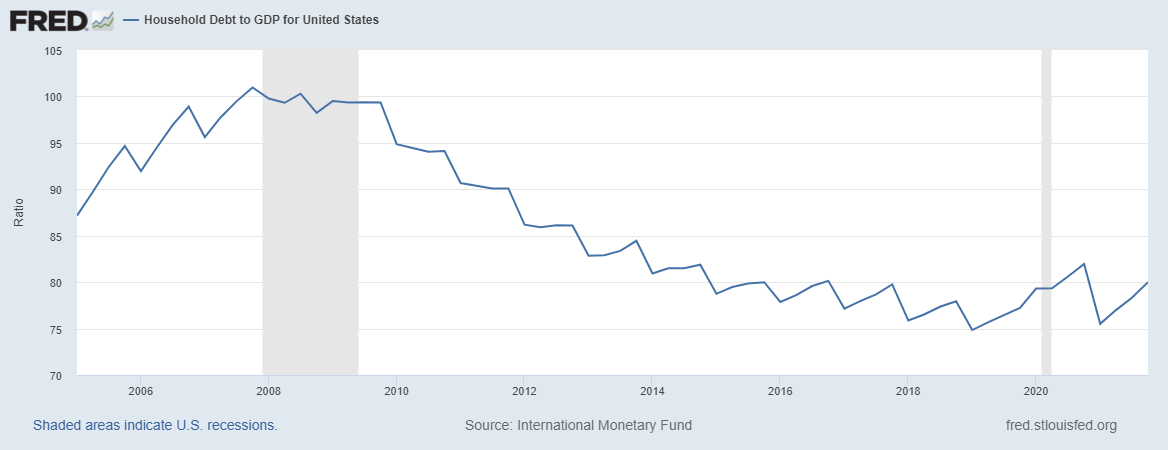Lately, with large companies announcing retrenchments and interest rates starting to rise, some concerns that the current surge in housing prices could potentially end up like 2008 are making their rounds.
While these concerns are understandable, there are distinct differences between this downturn and the 2008 recession. Three main differences between then and now explain why these worries are unfounded.
1. Stock Valuation Aren't That Far-Fetched
When it comes to the stock market, the similarities between 2008 and today are obvious. Both eras saw a rapid appreciation in equity prices, leading valuations to rise to near-historic levels. Some experts even think we are experiencing an “everything bubble,” where asset prices are way over-valued.
One of the most prized measures of the stock market’s relative value is Yale economist and Nobel laureate Robert Shiller’s cyclically adjusted price-to-earnings (CAPE) ratio. Currently, the ratio stands at 36.67, while before 2008, it was measured between 25 and 27. The CAPE ratio has only ever been higher than today during the dot-com era in late 1999 and 2000.
However, CAPE is just one old method of stock valuation. There are many other ways to measure valuation and many financial market experts of today say the stock market is valued differently than it used to be. Many tech analysts vouch that the current growth trajectory is dramatically different today than in 2007 before the financial crisis.
Tech valuations relative to growth, for example, are cheaper by about 25% than in 2007. This means that the naysayers only use metrics that support their overvaluation argument and do not look at the full picture. Stock valuation is not that stretched by today’s standard.
2. Housing Market Situation Is A Lot Better
The 2007-2009 financial crisis began with cheap credit and lax lending standards that fuelled a housing bubble. It began during a period of ultra-low interest rates and took several years to unfold. The only similar parts then and now lie with the low-interest rate only. The other parts of the equation are markedly different.
The subprime mortgage crisis preceded the stock market crash of 2008—a black swan event considered so rare as to be effectively impossible to predict. While the bulk of the damage was from the Bear Sterns-Lehman fallout, the crisis was initiated by the subprime mortgage crisis that affected Wall Street banks as subprime loans with poor borrower credit history were repackaged as low-risk financial instruments such as mortgage-backed securities (MBS) and collateralized debt obligations (CDOs) and sold to them.
Soon a big secondary market for originating and distributing subprime loans developed, and the availability of high leverage made trading in such toxic assets spiral out of control. Everyone bet that the housing market would go up forever.
When the bubble burst, financial institutions were left holding trillions of dollars worth of near-worthless investments in subprime mortgages. At the same time, millions of American homeowners found themselves owing more on their mortgages than their homes were worth, making it a double whammy for the banks since even repossessing that real estate could not help the banks recover the bad debts.
The losses on real estate lenders and brokers spread throughout the financial industry and eventually brought about several bank bankruptcies, including the biggest failure in US history, Lehman Brothers. However, the current housing market in the USA is very different from that in 2007.
According to US Census Bureau data, while US homebuilders produced 27.1 million homes between 2000 to 2010, that figure fell sharply to only 5.8 million between 2011 and 2021. This lack of production has led to a severe supply crunch in today’s housing market.
This means that the current surge in home prices may be more sustainable than it was back then, and a collapse is less likely, even if interest rates were to rise another few upticks. In 2008, the housing market was in oversupply.
Another reason why housing prices may not crash this time around is the Americans’ household indebtedness. This level is still some distance away from the unsustainable level reached in 2007, where according to Federal Reserve data, the debt of American households in 2007 was around 100% of GDP. That figure stands at only around 77% of GDP in 2021.
Hence, while I agree that the housing market will undergo a correction, it may not end up like the crash in 2007, which led to the insolvency of several mortgage brokers and eventually even took down Lehman.
3. Banking Sector Reforms
The key reason why this downturn may not end like 2008 is banking sector reform. After the 2008 crash, various regulations were put in place by the US Treasury to prevent such an event from happening again. One major reform was the passage of the Dodd-Frank Wall Street Reform and Consumer Protection Act in 2010.
The act restricted, to a large extent, the risky activities of banks and allowed increased government oversight of banking activities. The introduction of the Basel III requirement also forced banks on a global level to maintain larger cash reserves and reduce leverage. Basel III was implemented in 2009 and is still in effect today. Hence, the irrational credit over-extension in the 2000s that led to the eventual fallout in the financial industry has no chance of happening in the current context.
Basel III has three main components to reduce banking sector risk – Capital Requirement, Leverage Ratio, and Liquidity Requirements. The Basel III accord raised the minimum capital requirements for banks from 2% in Basel II to 4.5% of common equity as a percentage of the bank’s risk-weighted assets. There is also an additional 2.5% buffer capital requirement that brings the total minimum requirement to 7%.
As for leverage, the Federal Reserve Bank of the United States fixed the leverage ratio at 5% for insured bank holding companies and 6% for Systematically Important Financial Institutions (SIFI). Basel III introduced using two liquidity ratios – the Liquidity Coverage Ratio and the Net Stable Funding Ratio. The Liquidity Coverage Ratio requires banks to hold sufficient highly liquid assets that can withstand a 30-day stressed funding scenario as specified by the supervisors. The Liquidity Coverage Ratio (LCR) currently is 70% of the required liquid assets.
On top of the LCR, there is also the Net Stable Funding Ratio (NSFR), which requires banks to maintain stable funding above the required amount of stable funding for one year of extended stress. Hence, one can see that there are a variety of controls in place to prevent banks from incurring the kind of losses they made in 2008. When banks are safe, large contagion trickling down and paralyzing the economy is prevented.
Of course, that is not to say that we will not see a painful fall in asset prices and an inevitable recession should the job market and economy deteriorates. What I am trying to say is that the catastrophic level type of fallout that was 2008 is not likely to happen again this time around.
The economy could be hurt should the lockdowns be back again, and consumers could be the worst hit this time with inflation still rising. However, a systematic failure of the financial industry is not likely to repeat. The surge in counterparty risks that highlighted the 2008 crisis cannot happen again due to the strict regulations and high capital requirements that banks need to comply with.
Conclusion
Comparing the situation now with that of 2008 consoles, even myself. Even when all the measures are in place to avoid another hard landing of the economy, the Fed will be quick to revert to easing once any signs of a large dip in housing prices or the stock market are seen.
The Fed has much more room to maneuver now since they can do quantitative easing (QE). When things deteriorated to that extent in 2008, such innovative methods of pumping liquidity into the financial markets were not yet invented.
Also, bulls should not wait to pounce. Once the Fed shows signs of deliberation about whether to continue tightening would be the time the markets could start to stage a spectacular recovery.
